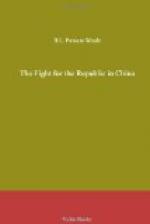If the situation which arose on the 15th August, 1914, is to be thoroughly understood, it is necessary to pick up threads of Chino-Japanese relations from a good many years back. First-hand familiarity with the actors and the scenes of at least three decades is essential to give the picture the completeness, the brilliancy of colouring, and withal the suggestiveness inseparable from all true works of art. For the Chino-Japanese question is primarily a work of art and not merely a piece of jejune diplomacy stretched across the years. As the shuttle of Fate has been cast swiftly backwards and forwards, the threads of these entwining relations have been woven into patterns involving the whole Far East, until to-day we have as it were a complete Gobelin tapestry, magnificent with meaning, replete with action, and full of scholastic interest.
Let us follow some of the tracery. It has long been the habit to affirm that the conflict between China and Japan had its origin in Korea, when Korea was a vassal state acknowledging the suzerainty of Peking; and that the conflict merited ending there, since of the two protagonists contending for empire Japan was left in undisputed mastery. This statement, being incomplete, is dangerously false. Dating from that vital period of thirty years ago, when Yuan Shih-kai first went to Seoul as a general officer in the train of the Chinese Imperial Resident (on China being forced to take action in protection of her interests owing to the “opening” of Korea by the American Treaty of 1882) three contestants, equally interested in the balance of land-power in Eastern Asia were constantly pitted against one another with Korea as their common battling-ground—Russia,




